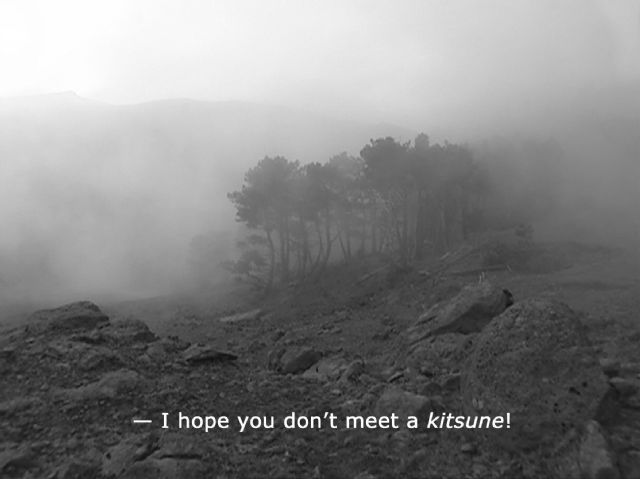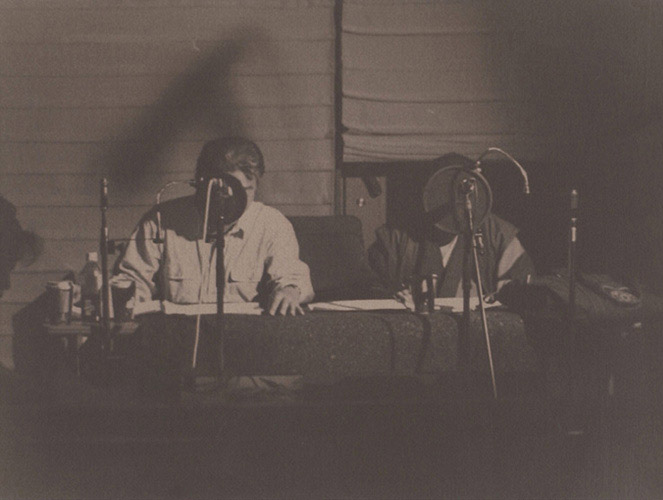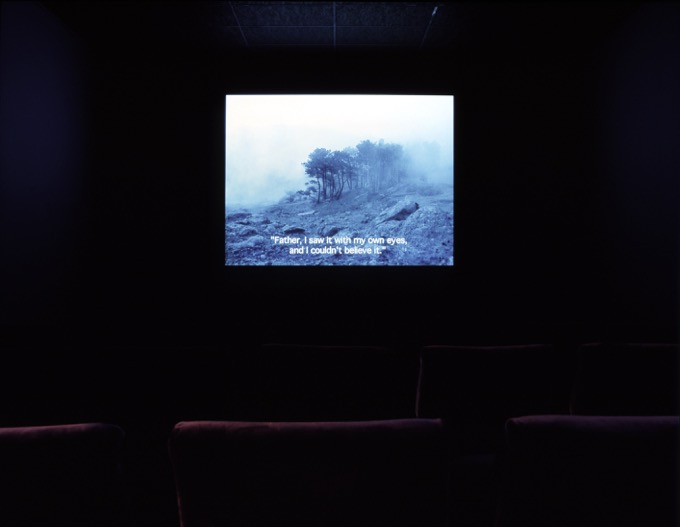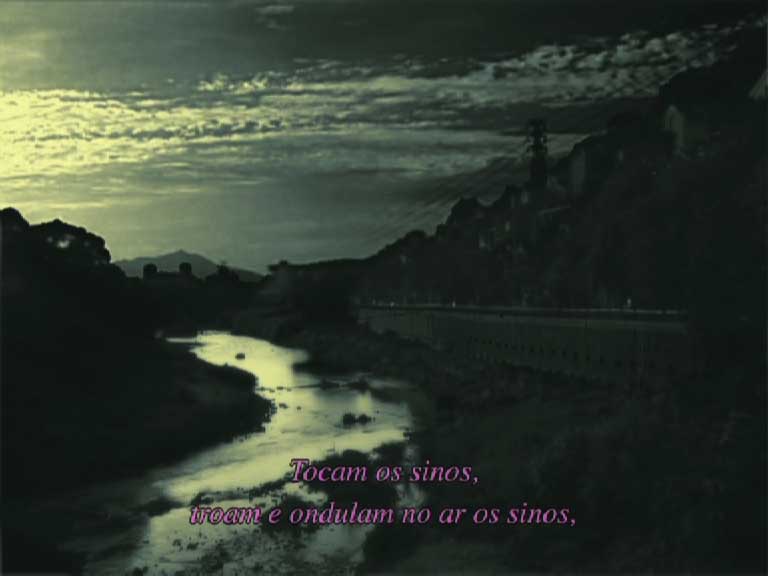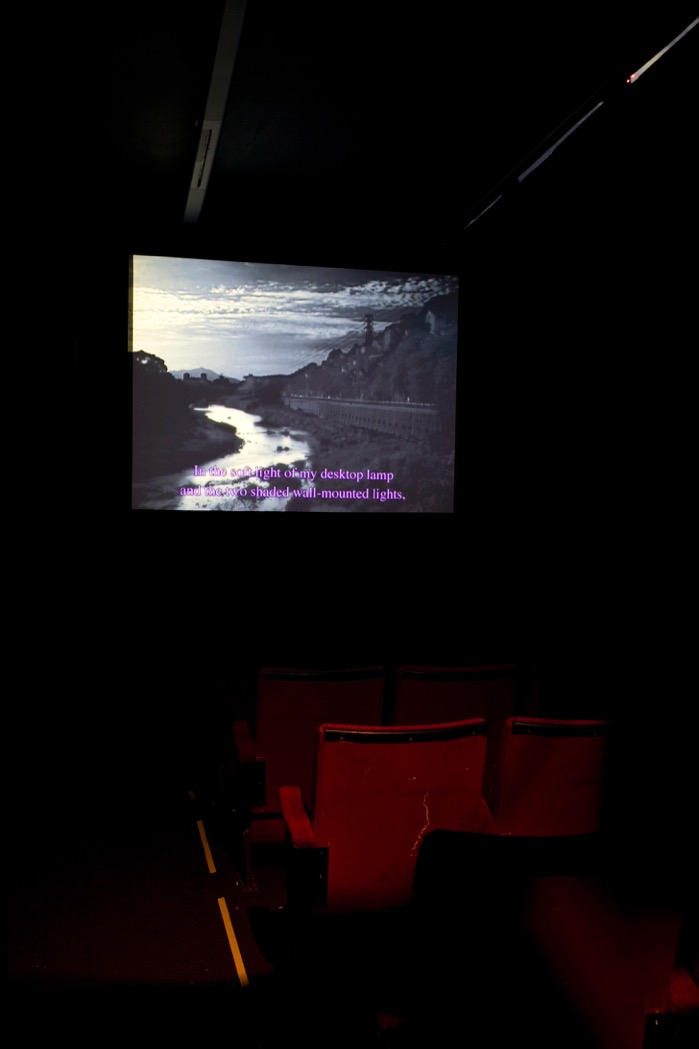| HOME | PRESENTACIÓN | ¿FILMAR LA HISTORIA? | DIRECCIÓN-REDACCIÓN | NÚMEROS PUBLICADOS | NORMAS DE PUBLICACIÓN | CONTACTOS | ENLACES |
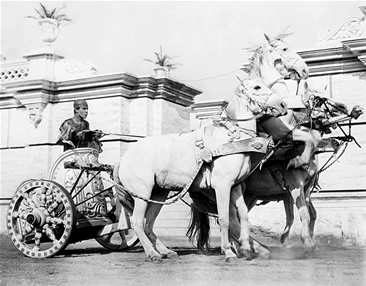 |
JOÃO PENALVA João Penalva e o espírito do storytelling Lcdo. Carlos Vargas
Recibido el 1 de Diciembre de 2014
Abstract. João Penalva tells stories. And in doing so he uses whichever media and mechanisms are best suited to the needs of narrative exposition.
The artist uses painting, photography, and frequently film, whether on their own or in combination. In settings of varying complexity, Penalva repeatedly draws on text as one of the effective mechanisms for the construction of imaginaries which deceive the viewer in an apparent naiveté of purposes.
This text will analyse the film A harangozó [The Bell-Ringer], by João Penalva, as an exemplary case of narrative construction through film, in which text plays a decisive role.
Resumo. João Penalva conta histórias. E ao fazê-lo socorre-se de suportes e mecanismos que, em cada caso, melhor respondem às necessidades das narrativas.
O artista recorre à pintura, à fotografia e, tantas vezes, ao cinema, isolados ou em conjunto. Em montagens mais ou menos complexas, Penalva convoca, com assinalável frequência, também o texto como um dos mecanismos eficazes para a construção de imaginários que procuram iludir o espectador, numa aparente ingenuidade de propósitos.
Neste artigo, analisaremos o filme A harangozó [O Sineiro], de João Penalva, como um caso exemplar de construção narrativa através do cinema, em que o texto joga um papel determinante.
For JP The spirit of storytelling In 2010, Anders Kreuger, the curator of the João Penalva exhibition at Lunds konsthall, in Lund, Sweden, wrote: ‘I have often thought of João Penalva as a writer who has found an ingenious format for publishing his texts, very suitable in the visual art context. He shows them, disguised as English subtitles to long text-sound compositions that include moving images in which nothing much happens, a voice-over in a language that to most viewers becomes an unintelligible musical experience when it is not translated, and a carefully post-produced soundscape serving as effective infrastructure.’ (João Penalva [Catalogue], 2010: 65). In 2000, in response to the first exhibition of acquisitions from the contemporary art collection of IAC – Institute of Contemporary Art/CCB – Centro Cultural de Belém, in Lisbon, Isabel Carlos wrote of João Penalva’s installation, Personagem e Intérprete (1998) [Character and Player]: ‘Where does fiction begin and reality end? What is true and what is false?’ (Initiare [Catalogue], 2000: 84). In 1995, in relation to The Story of the Princess and the Pea by Hans Christian Andersen, told in 6 parts (1995), shown by João Penalva at the Pedro Oliveira Gallery in Porto, João Fernandes wrote in the exhibition catalogue, alluding to the pea of the fable: ‘In this game of representation, and by erasing it as an icon, he reveals it as a credible linguistic sign. In this game of truth, it is the fact that it is hidden which will allow us to believe in it as a process for the revelation of an identity, in a pictorial and narrative construction which thereby assumes all the exemplarity of a fable, whose moral investigates an ontology of existence, aware that it can be falsified.’ (João Penalva [Catalogue], 1995: 14). João Penalva tells stories. And in doing so he uses whichever processes and supports are best suited to the needs of narrative exposition. Therefore his use of painting, photography and cinema, whether on their own or in combination, in settings of varying complexity within installations, repeatedly draws on text and language as effective mechanisms for the construction of imaginaries which deceive the viewer in an apparent naiveté of purposes (1). In the words of João Penalva: ‘I would like to think that I have no rules that I work by, but I would say that I much prefer that my working method is incorporated into the work itself in a precise, clear manner, and that this is seen through the work as a record of a performance.’ (João Penalva [Catalogue], 2005: 8-1). Moreover, the use of legends, fables, stories of wonder or tales inspired by myths – regardless of the cultural universes in which they originated – helps to create a common imaginary space which is easily shared with viewers, becoming a first step in a discreet and deliberate playing out of ambiguities. This is also achieved through Penalva’s use of short narratives drawn from everyday life in which we each see ourselves, echoed in the memory of past actions or in the nostalgia for distant, longed-for spaces. The development of successive intricate lines of narrative leads the viewer to a false shared space of individual memory; false because it unequivocally depends on personal memory (and is therefore not shared), subject to all that is illusory in memory itself. As Penalva says in a dialogue with João Fernandes, ‘Memory as we all know but tend to forget is a construction.’ The artist’s work therefore takes us to that land of illusion where, paradoxically, we feel safe and confident, a space of individual and unrepeatable creations, although ones associated with the common denominators of a shared culture (2). In fact the creation of these fictional worlds, whether through the rigorous technical execution of objects or the variety of the media employed (often simultaneously), is accentuated by the use of staged text, an integral part of the work of art (3), functioning as a mediator which establishes an idea of accessibility through the facilitating illusion of reading (4). And when the mystery behind the illusion is revealed or the pitfalled path we followed is revealed with striking irony, as in A Colecção Ormsson apresentada por João Penalva (1997) [The Ormsson Collection presented by João Penalva] or Barry Kovacks (1995) (5), we did not walk through unknown lands but rather along trails we thought we knew from the dreams of our memory, led by the safe hand of one who strives to give us back the possibility of the real.
Who is ringing the bells? By constructing a solid imaginary rooted in verisimilitude, João Penalva thus offers a simulacrum of the real, as if it had not been expelled from reality by the symbolic. It is in the inner realm of dreams, then, that we are immersed in the possibility of a ‘real’ that is ‘true’ because it has been rediscovered (6). And that invitation, engaging the viewer in the possibility of a rediscovery, is clearly and intensely visible in the films of João Penalva. A harangozó [The Bell-Ringer], 2005 (7), 55 minutes, 30 seconds, was commissioned by the Ludwig Museum in Budapest, where it received its premiere. The film is narrated in Hungarian with Portuguese or English subtitles and is remarkable in that the image is played backwards and forwards simultaneously, cancelling out the current of a river. (We will return to this below.) Suspended by this unending and immutable image, the viewer is inevitably taken on an inner journey. This near suppression of the movement in the image of the film (8), further intensified by the static shot, seems an attempt to eliminate the cinematic character of cinema, provoking in the viewer a sense of strangeness, and therefore of distance. For João Penalva, ‘we are talking about the lens being the great storyteller. Film and video capture reality and reproduce it as a “fictionalised reality”.’ (João Penalva [Catalogue], 2005: 13-1). A second sense of strangeness is caused by the narration in Hungarian, in a slow incantation befitting the reading of an epic poem. On this, Penalva states: ‘(...) the foreignness of a spoken language that requires a translation acts as a distance, a distance reinforced by the reading that will give access to it. One is very much aware of this mediation that one is asked to perform. Those foreign languages, mediated through subtitles, may place you in a position where your reading pattern and your breathing pattern will adapt to that of the voice speaking in the language you hear but may not understand, and for which you will find – I hope – a syntony in your own body.’ (João Penalva [Catalogue], 2005: 13-1). The re-engagement of the viewer takes place through the introduction of text as subtitles, a means of decoding language (in this case Hungarian) and its prosody. The artist is clear in his intentional use of the mechanisms of reading: ‘What I am after is that the timing between the reader and the speaker becomes one; that the reader breathes together with the speaker. This closeness to the spoken word makes for unusual reading rhythms and requires a constant alertness from the reader.’ (João Penalva [Catalogue], 2005: 18-2). Paradoxically, the text, as a continuous flow of words presented in the form of subtitles, replaces the immobilised current of the river, a cold background image which requires the gaze to remain fixed upon it. ‘I am told that if you take your eyes from the screen for a moment you may lose the thread and be lost. That sounds fine to me.’ (João Penalva [Catalogue], 2005: 18-2).
Penalva constantly makes demands of the skills of the viewer. All the information is available, whether hidden or not, but discovery depends on the possibilities of each of the viewers and, inevitably, on their cultural heritage. And in this area the ambiguities of João Penalva’s work are intensified. Kitsune (2001) was shot on the island of Madeira; it is spoken in Japanese and introduces us to traditional Japanese tales (9). On the manner in which the film is experienced, Penalva said: ‘If it looks like a Kurosawa film, it does so because you hear the language of a Kurosawa film. But if I were to use the same image with the voices of Swedish actors, Bergman would be your cultural reference and you would immediately identify it as unmistakably Swedish.’ (João Penalva [Catalogue], 2005: 11-2). This echoes the writing of Barthes, who said: ‘The more a story is told in a proper, well-spoken, straightforward way, in an even tone, the easier it is to reverse it, to blacken it, to read it inside out (Mme de Ségur read by Sade). This reversal, being a pure production, wonderfully develops the pleasure of the text.’ (Barthes, 2009: 148).
However, the final engagement, which will bring the viewer to a familiar and physically comfortable territory, is the external mise-en-scène borrowed from the cinema: ‘(...) my mise-en-scène is first of all a tool. Why is the setting for 336 PEK (1998), Kitsune (2001), The Bell-Ringer (2004) or The White Nightingale (2005) a cinema? These video pieces are close to one hour long and if one is going to stay the course one has to be comfortably seated. The mise-en-scène of a cinema immediately communicates the message that a long time is going to be spent in the dark but, unlike the common video installation, here there are cinema chairs that communicate that this is just like when you go to the cinema.’ (João Penalva [Catalogue], 2005: 3-2 and 4-2).
Der Erwählte [The Holy Sinner] The Bell-Ringer was written by João Penalva, like all of his films, and contains excerpts from Der Erwählte [The Holy Sinner] by Thomas Mann. This work, written in 1951, is a historical novel (10) about the incestuous love between Wiligis and Sibylla, the birth of Gregory, their child, Gregory’s incestuous marriage years later to his beloved Sibylla (his mother), the penitence of both and the coronation of Gregory upon the Chair of Saint Peter in Rome as a saint among men. After Doctor Faustus, written some years previously, this is a novel of redemption which believes more in the idea of benevolence and community than in the canonical Christian perspective of punishment, penitence and excommunication (11).
’Who rings? The ringing of bells, the surging and swelling of bells supra urbem, above the whole city, in its airs overfilled with sound. Bells, bells, they swing and sway, they wag and weave through their whole arc on their beams, in their seats, hundred voiced, in Babylonish confusion. Slow and swift, blaring and booming – there is neither measure nor harmony, they talk all at once and all together, they break in even on themselves; on clang the clappers and leave no time for the excited metal to din itself out, for like a pendulum they are already back at the other edge, droning into its own droning; so that when echo still resounds: “In te Domine speravi,” it is uttering already “Beati quorum tecta sunt peccata” into its own midst; not only so, but lesser bells tinkle clear for smaller shrines, as though the mass-boy might be touching the little bell of the Host.’ (Mann, 1992: p. 10, lines 1-16).
On his path to the glory of God, Gregory walks the holy way of the incestuous until he is elected Pope and reincarnates the myths of Narcissus and Oedipus. Returning to medieval times and a Europe still in formation, Thomas Mann constructs a narrative in another time to introduce issues pertinent to his own (12): the reconstruction of Europe itself, the redemption of man after the macabre horror of the Nazis, the reduction of violence (Gregory, as Oedipus, does not kill his father) and the possibility of the inclusive and redemptive pardon attained by man. It is a new path to sainthood, in spite of God and His distractions, which stimulates recognition and the sense of community instead of exclusion and difference (13). ‘Ringing from the height and ringing from the depths; from the seven arch-holy places of pilgrimage and all the churches of the seven parishes on both sides of the twice-rounding Tiber. From the Aventine ringing; from the holy places of the Palatine and from St. John of the Lateran; above the grave of him who bears the keys, in the Vatican Hill, from Santa Maria Maggiore, Santa Maria in Foro, in Dominica, in Cosmedin and in Trastevere; from Ara Celi, St. Paul’s outside the Walls, St. Peter in Chains, and from the house of the Most Holy Cross in Jerusalem. And from the chapels in the cemeteries, from the roofs of the basilicas and oratories in the narrow streets come the sounds as well. Who names their names and knows their titles? As when the wind, when the tempest rakes the strings of the Aeolian harp and rouses the whole world of sound, the far apart and the close at hand, in whirring, sweeping harmony; such, translated in bronze, are the sounds that split the air, for here everything that is rings for the great feast and high procession.’ (Mann, 1992: p. 3, line 17 to p. 4 line 15). The text written by Penalva is interspersed with excerpts from Mann’s text, changing their original order in The Holy Sinner andrepeating them cyclically (14). This almost liturgical rite accentuates in the viewer, now a reader, the contamination of verisimilitude essential to the historical novel. To the unsuspecting reader, who only has access to the cinema-text, or rather the text-as-cinema, in the uninterrupted sequence of subtitles, without cuts or signs, in a single narrative punctuated by the emergence of narrative suspensions from Der Erwählte (distinguished only by italics), the viewer experiences the phenomenon of the contamination of verisimilitude from one text to the other, at each moment, in the text-cinema that will follow. ‘Who is ringing the bells? Not the bell ringers. They have run into the street like all the folk, to list the uncanny ringing. Convince yourselves: the bell-chambers are empty. Lax hang the ropes, and yet the bells rock and the clappers clang. Shall one say that nobody rings them? – No, only an ungrammatical head, without logic, would be capable of such utterance. ‘The bells are ringing’: that means they are rung, and let the bell-chambers be never so empty. – So who is ringing the bells of Rome? – It is the spirit of story-telling. – Then can he be everywhere, hic et ubique, for instance at once on the Tower of St. George in Velabro and up in Santa Sabina, which preserves columns from the abominable Temple of Diana? At a hundred consecrate seats at once? – Of a certainty, that he can. He is as air, bodiless, ubiquitous, not subject to distinctions of here and there. He it is that says: “All the bells were ringing”; and, in consequence, it is he who rings them. So spiritual is this spirit and so abstract that grammatically he can be talked of only in the third person and simply referred to as “It is he.” And yet he can gather himself into a person, namely into the first person, and be incarnate in somebody who speaks in him and says: “I am he. I am the spirit of story-telling’ (Mann, 1992: p. 4, line 16 to p. 5 line 9). Just as the single image is the setting for the text-as-image sequence, so the historical novel, diluted in the integrity of the new narrative, serves as the backdrop, or ‘element of verisimilitude’, for the fiction based on reality and associates itself with it without compunction. ‘Who, sitting in his time-place, namely in the library of the cloister of St. Gall in Allemannenland, where once Notker the Strammerer sat, tells this story for entertainment and exceptional edification; in that I begin with its grace-abounding end and ring the bells of Rome: id est, report that on that day of processional entry they all together began to ring of themselves.’ (Mann, 1992: p. 5, lines 9-16). To the ‘fictionalisation of reality’, the term used by João Fernandes (João Penalva [Catalogue], 2005: 13-1), we should then add this effect of the correction of reality through verisimilitude (15), namely, through that which appears to be true. This process of obsessive construction of a simulacrum of the real – a simulacrum because it is naively false – will be accentuated by the (apparent) fixity of the image and by the slow descriptive process with which the narration begins. Surprised by the duration of the image, the viewer does not suffer the pressure of choice; he welcomes the (true) steadiness of the gaze and, as a reader, surrenders himself to the pleasure of the text.
For entertainment and exceptional edification ‘The image of The Bell-Ringer is composed of many separately processed elements taken from the image of a river and its banks, in Taipei, filmed from a bridge which is part of a highway at the edge of the city. The sound of cars was deafening. Almost immediately opposite, on the other side of the bridge, are the famous Taiwan film studios – the Central Picture Corporation Studios. The filmed image lasted just 20 seconds. Masks were made for the sky, which was frozen and given different light, colour and contrast. The same process was applied to the left and right banks, but without freezing them. Indeed, the trees move. A mask was also made for the river, making it much lighter than the original — it looks like silver. After processing the image, a version of the film running from the beginning to the end was superimposed over a version running from the end to the beginning. Hence, at the very beginning, a man can be seen both seated and standing up. He came and sat down. That was all. The current of the river was quite strong but it was cancelled out by the superimposition, leaving only a sort of swirl in the widest section. The sound is predominantly from Tokyo (the crows) and from an abandoned tourist village close to Mount Fuji (the rain). The voice is that of László Szacsvay, a very popular Hungarian actor with an extensive career.’ (16). Thus we are faced with a sophisticated construction of an (apparently) single image – the image of the film – the result of painstaking post-production. The suspension of the image seems to contribute to the peaceful fixing of the viewer’s gaze, in guaranteeing the veracity of the documented event: there is no rush, this is the here and now. In this way, by establishing a pact of truth with the viewer, Penalva allows the appropriation of the image, in each person’s inner journey, without the conventional time constraints associated with reading images in films and, at the same time, freeing the gaze for the text-as-cinema. When asked by João Fernandes about the use of a static shot, the artist is very clear about his objectives: ‘Because only a single continuous shot can record what happened at a certain time, during a certain time, in a certain place. When I film I never feel too far from being a security camera, spying. So, we are again talking about recording, in a documental way, what I regard as an event. This event may also be construed as a ‘found’ narrative, but it only interests me as something towards which I did not contribute but that contains beautifully structured, miraculously composed time. Then, without altering its continuity, I place against it other timings that can be those of sound and language, both spoken and visual, as subtitles. The tensions that are produced from these placements generate unexpected meanings.’ (João Penalva [Catalogue], 2005: 19-1). In fact we are referring to the suspension of time, enhanced by the effect of the descriptive manner in which the artist begins The Bell-Ringer. Underpinned by the voice ofászló Szacsvay, in his aoidos prosody, the description of the city, the city streets from the outside to the inside, finally concentrating on the description of the consulting room, constitutes in itself a mechanism for suspending the time of the narrative introduced by the image, which is also suspended by Penalva. Like the monk who, in Der Erwhälte, tells us the incestuous story of the two siblings from the cell of the Monastery of St. Gallen, in Penalva's original narrative in A harangozó we also find a narrator seated in his study who draws us into the narrative. The February afternoon is the time of a room whose inner geography is described in detail: the lamps, the Persian rug, the location of the door, the window and the desk, the diplomas on the wall, the bookcase and its shelves, the medicine cabinet commissioned especially so as to avoid being painted the conventional white, the leather armchairs and the map of Europe. Returning to Roland Barthes: ‘Why do some people, including myself, enjoy in certain novels, biographies, and historical works, the representation of the “daily life” of an epoch, of a character?’ (Barthes, 2009: 171). The insignificant details, the accumulation of small elements, the veracity of the account of someone who is actually familiar with the space, hides an aesthetic effect underpinned by the banality of what is described. ‘Banality becomes beautiful for being a vestige of what is true.’ For that reason, Penalva states: ‘If you want to look at the moving fog in Kitsune, or the people strolling through a park in 336 PEK, (…) those chance events are quite memorable images but they are also truly ordinary. If they become extraordinary in the mind of the viewer it is only because they have been transferred to film and their real timing has become “film time”.’ (João Penalva [Catalogue], 2005: 19-2).
In fact, the mechanism of (false) suspension of the image allows the image itself to be trivialised by its indeterminate suspension, by the possibility of accumulating details which would otherwise have eluded the viewer in the fleeting mirage of an instant (17). It is therefore a new descriptive effect which accentuates the previous one, now enhanced by the ‘phantasmagorical effect of what is true’ (Rancière, 2010: 38). Moreover, once the denotative effect of these accumulated details has been lost, reality is represented with a connotative sense. Barthes refers to an effect of reality: ‘il se produit un effet de réel, fondement de ce vraisemblable inavoué que forme l’esthétique de toutes les œuvres courantes de la modernité.’ (18). João Penalva’s work, then, is an exercise in freedom by drawing our gaze to a cinema which requires a viewer free from boredom who escapes the rigidity of the norm. And in Penalva’s films, the effect of reality referred to by Barthes sets us the challenge faced by the witness in the courtroom who must point his finger at the defendant standing before him. Reality transformed into a defendant faces the challenge of the image shown, without escape, or in the words of Eduardo Prado Coelho, ‘in the density of its meanings’.
João Penalva videography 336 PEK (336 Rios), 1999 Kitsune (The Spirit of the Fox), 2001 A harangozó (The Bell-Ringer), 2005 The White Nightingale, 2005 The Roar of Lions, 2007 João Penalva catalogues (selection)
Notes (1) ‘João Penalva is known for producing large-scale installations in various media, as well as more intimate works with video and slide projections, sound, drawing, painting and found materials. Through these media Penalva addresses narrative modes and the relationships between images, text, language and sound. His storytelling is often fractured, presenting juxtaposed narrative elements, allowing the viewer a latitude of freedom in their interpretation.’ Simon Lee Gallery, London. http://www.simonleegallery.com [retrieved on 23 November 2011]. (2) ‘But if you ask me whether what I write is “literature”, of course I will say it is. Actually, I have been told so many times that “I should really be a writer” – as if I weren’t one – that I am beginning to see the extent to which there is here a confusion between the medium and the support.’ (João Penalva [Catalogue], 2005: 6-3). (3) ‘The visual “evidences” would get lost without the written or pronounced texts in the flow of information and vice versa; the interpretation of the texts would end up in but a vague attempt without the accompanying images. Side by side they will hopefully direct our attention to their mutual dependency.’ Ludwig Múzeum, Budapest. João Penalva - Retrospective Exhibition, 3 November 2005 – 15 January 2006. http://www.ludwigmuseum.hu/index.php [retrieved on 23 November 2011]. (4) Isabel Carlos says: ‘Reading and seeing, reading or seeing therefore become crucial actions in Penalva's work. Both reading and seeing imply an act of interpretation: we interpret an image in the same way that we interpret a sentence from a text. The context determines the two fields of interpretation. We interpret an image in relation to the image appearing before or how long that image is shown for; if we then add voice or text, the field of interpretation expands exponentially.’ Centro de Arte Moderna - Calouste Gulbenkian Foundation. (5) ‘As you said, when you talked of “fables”, Barry Kovacks is the closest I have written to that literary genre, but my problem with the fable is its “morality”. There is no scope for more than one – let alone for opposite ones – and I don’t feel comfortable with this singularity.’ (João Penalva [Catalogue], 2005: 7-2). (6) In this respect, see Jacques Lacan, The Four Fundamental Concepts of Psychoanalysis, (Jacques-Alain Miller ed.), Hogarth Press, London, 1977. ‘Literature cannot exceed any of these orders in coming to fruition. Through the imaginary it connects the symbolic to the ever-invisible real; with the symbolic it invents an imaginary of this reality; by ceaselessly seeking out the real, based upon it, it brings into play the link of the imaginary in the symbolic.’ Maria Belo. E-Dictionary of literary terms. <http://www.fcsh.unl.pt/invest/edtl/verbetes/R/real.htm> [retrieved on 25 November 2011]. (7) The first public presentation of The Bell-Ringer was in Portugal, in May 2008, during the season dedicated to João Penalva. http://www.curtas.pt/solar/index.php?menu=274&submenu=281 [retrieved on 23 November 2011]. (8) ‘Like science, cinema works with a set of facts and has the ability to reduce larger phenomena to primary components. At the same time, cinema, like the other arts, draws its material from mythology. The resulting cinematic experience is the sum of several processes operating together. Visual forms converging with factors of meaning create tensions which must be attended to.’ SHARFF S., The elements of cinema: toward a theory of cinesthetic impact, Columbia University Press, 1982, 173. (9) “In Kitsune, a film by Penalva, we see a rocky-wooded landscape where, apart from the slow motion of fog, we can follow the Japanese dialogue of the two invisible male protagonists subtitled in other languages. During watching the film, viewers might have various associations of the relationship between the images and the text heard, till they are informed in the credits that the film was shot on a Spanish island. Our stereotyped associations of ideas will thus question themselves post festam.” Ludwig Museum, Budapest. João Penalva – Retrospective Exhibition 3 November 2005 – January 15 2006. <http://www.ludwigmuseum.hu/index.php> [retrieved on 23 November 2011]. (10) ‘The story is based in the main on the verse epic Gregorius von Stein by the Middle High German poet Hartmann von Aue (c. 1165-1210) who took his legend of chivalry from the French’ (Mann, 1961). (11) ‘Wiligis and Sibylla love each other because they are identical and no one is their equal, but their son finally becomes the embodiment of a love for the world, and his bildungsroman is the narrative of a passage from hermetic particularity to a universalist embrace. Its optimism entails the promise that one can become an individual without renouncing society, the world, and the others within it.’ (Russell A. Berman, Introduction in Mann, 1992: X). (12) ‘(…) by focusing their critiques of society on imaginatively distant settings, dystopian fictions provide fresh perspectives on problematic social and political practices that might otherwise be taken for granted or considered natural and inevitable.’ BOOKER K., Dystopian literature: a theory and research guide, Greenwood Press, 1994, pp. 3 – 4. João Penalva makes use of this mechanism in The Roar of Lions, 2007. (13) ‘Rejecting both particularistic separatism and abstract universalism, Gregory reigns “in spirit of enlightenment”, an enlightenment that entails the recognition, rather than eradication, of difference.’ (Russell A. Berman, Introduction in Mann, 1992: XVIII-XIX). (14) João Nisa writes: ‘By presenting several narrative fragments touching upon the themes of the double and suicide, which appear to arise out of each other, and may be understood as ramifications of the same story or as parts of different units, the text in some way duplicates the circular effect of the image, being regularly interrupted by a refrain – consisting of an excerpt from Der Erwhälte (1951) by Thomas Mann, which explicitly refers to the process of elaborating the narrative.” (João Penalva [Catalogue], 2011:31). (15) ‘(...) as a way to correct reality through verisimilitude.’ We closely followed the line of argument of Carlos Reis concerning the historical novel and Alexandre Herculano. REIS C., ‘Herculano e a ficção romântica’ in Construção da Leitura, Coimbra, INIC, 1982, 106. (16) Information from a conversation with João Penalva. (17) Deleuze talks of the cinema of the movement-image, action-image and time-image. An illuminating essay has been written on this subject by Cíntia Gil. “Image and temporality: contemporary spectator and experience.” in VILELA, E. (coord.), Arquipélagos de sentido. Estética(s) e artes I, Afrontamento Editions, Porto, 2011, 43-65. (18) BARTHES R., ‘L'effet de réel.’ Communications. Recherches sémiologiques le vraisemblable. 11, 1968, 88.
Bibliography BARTHES R., O prazer do texto, Edições 70, Lisbon, 2009.
ISSN 1988-8848
|
